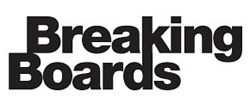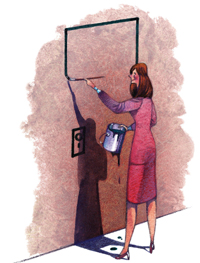 You
don't need to be a martial artist to crack the boardroom,
but for women this goal remains elusive. Here's how Kellogg
is helping open more doors to governance
You
don't need to be a martial artist to crack the boardroom,
but for women this goal remains elusive. Here's how Kellogg
is helping open more doors to governance
By Shannon Dunlap
A group of executives enters the wood-paneled
room. The individuals take seats around a long, impressive
table. As directors of a company, they are talented, committed
and ready to guide the firm. And they are all white men.
This is what a boardroom looked like 50 years
ago; unfortunately, too often today's reality still mirrors
that bygone time.
| |
 |
| |
|
The enduring problem of gender disparity in
business extends beyond mere decorum, or even more lofty ideals
of equality. It hurts the bottom line. In contrast, diversity
can help make boards more efficient and effective. "Broadening
the pool of potential director talent makes good business
sense," says Victoria Husted Medvec, the Adeline Barry Davee
Professor of Management and Organizations and executive director
of the Kellogg School's Center for Executive Women (CEW).
Yet even at well-intentioned companies, the progress toward
more diverse boards is glacial. According to the most recent
report from Catalyst, women occupy just 13.6 percent of Fortune
500 board seats.
At Kellogg, corporate governance has long
been a focus. For 14 years, the school's annual Corporate
Governance Conference has convened directors from a range
of industries to discuss challenges and pertinent topics.
Recently, Kellogg has also turned its attention to accelerating
board diversification by offering two executive education
courses that address this issue: the Women's Director Development
Program and the Minority Director Development Program.
The women in the Women's Director Development
Program are well aware of the problem confronting them
and know that gaining entry to the boardroom is no easy task.
So, in preparation, they leverage the CEW's resources to hone
skills such as effective board decision-making and analysis
to detect potential errors in financial statements. In addition
to teaching sound director techniques, the program also addresses
the challenges of being a female director. Participants discuss
how to ensure that they are more than token members by evaluating
board opportunities and by amplifying their voices in the
boardroom. "The thought of being a new board member and, in
many cases, the only woman on the board, can be a little daunting,"
says Elizabeth Hartigan Connelly '91, a managing director
at J.P. Morgan Chase and a recent CEW participant. "The skills
we learned during the program will allow us to walk into a
boardroom with confidence."
The Center also maintains a database of potential
board candidates, and all participants in the Women's Director
Development Program are invited to submit their résumés
for inclusion. Kellogg makes this information freely available
to nominating committees and search firms seeking new board
members. Eileen Kamerick, CFO of Heidrick & Struggles, was
a participant in one of the program's first sessions in 2002
and now sits on the boards of two companies: The ServiceMaster
Co. and Westell Technologies. "Finding the right kind of board
for your first director experience can be a challenge," says
Kamerick, who now frequently returns to Kellogg to speak in
the program. "The database surfaces fresh talent who may have
been overlooked."
Like Kamerick, program alumnae who now serve
on boards often return to contribute to Kellogg panels. "Having
program alumnae share their stories and insights as panelists
is valuable because these women have recently moved into the
boardroom and can talk about their experiences as new board
members," says Medvec. The program's faculty also includes
very experienced directors, experts on D&O insurance and Sarbanes-Oxley,
and partners from leading firms who conduct director searches.
Such efforts are making a difference.
Walter Scott, professor of management and
Senior Austin Fellow at Kellogg, helped found the Center for
Executive Women. He sees more and more alumnae of the program
at the Corporate Governance Conference where he serves on
the steering committee. "Every year, there are more exceptionally
qualified women directors invited to this international conference,"
Scott says. "Gifted women directors contribute new perspectives
and insights which make the discussions richer and more stimulating.
All the attendees benefit."
Lloyd Shefsky,
clinical associate professor of entrepreneurship and family
enterprise, and another CEW co-founder, is pleased with the
Center's efforts and believes them important for ameliorating
the landscape of corporate management.
"Though some
believe the glass ceiling has been shattered, women continue
to be passed over, due to lack of experience in the very positions
to which they aspire," says Shefsky. "The only way
to break the vicious cycle is with education and training,
which the Kellogg Center for Executive Women provides. The
Center is already making a difference.
Shefsky adds that
history may note that Kellogg helped break the "logjam"
and was "indirectly responsible for the proportionate
and appropriate selection" of women as corporate executives
and directors.
"Then, the
unique value that women can bring to boards and executive
suites will prove valuable to all our society," he says.
Kellogg looks forward
to bringing both a new look and fresh talent to the boardroom.
"It's exciting to see that we're having a real impact on boards,"
says Medvec, "Kellogg is helping transform the face of corporate
America."
|



